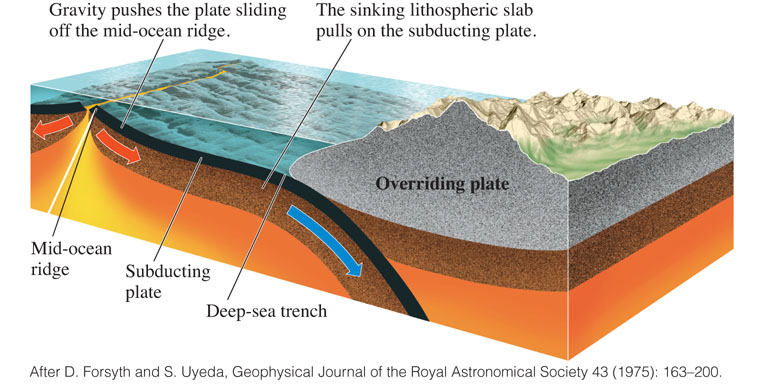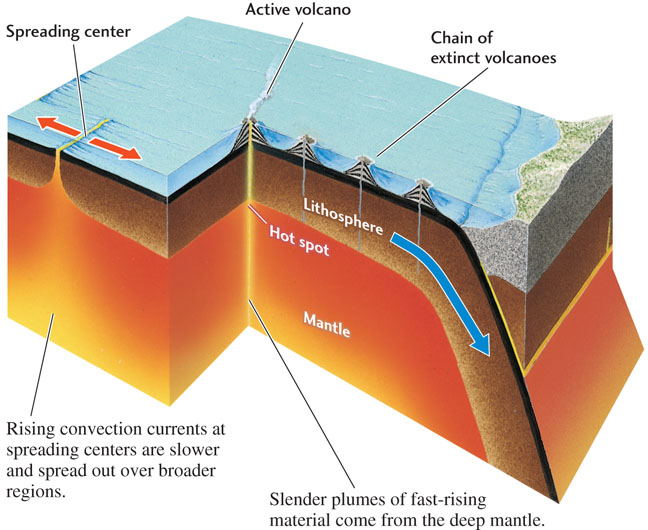Mantle Convection: The Engine of Plate Tectonics
Everything discussed in this chapter so far has been a description of how plates move. The theory of mantle convection provides an explanation of why plates move.
As Arthur Holmes and other early advocates of continental drift realized, mantle convection is the “engine” that drives the large-scale tectonic processes operating on Earth’s surface. In Chapter 1, we described hot mantle as a ductile solid capable of flowing like a sticky fluid. Heat escaping from Earth’s deep interior causes this material to undergo convection (circulation upward and downward) at speeds of a few tens of millimeters per year.
Almost all scientists now accept that the lithospheric plates somehow participate in the flow of this mantle convection system. As is often the case, however, “the devil is in the details.” Many different hypotheses have been advanced on the basis of one piece of evidence or another, but no one has yet come up with a satisfactory, comprehensive theory that ties everything together. In what follows, we will pose three questions that get at the heart of the matter and give you our current understanding of their answers. But the study of the mantle convection system remains a work in progress, and we may have to alter our views as new evidence becomes available.
Where Do the Plate-Driving Forces Originate?
Here’s an experiment you can do in your kitchen: heat a pan of water until it is about to boil, then sprinkle some dry tea leaves in the center of the pan. You will notice that the leaves move across the surface of the water, dragged along by the convection currents in the hot water. Is this the way plates move about, passively dragged to and fro on the backs of convection currents rising up from the mantle?
The answer appears to be no. The main evidence comes from the rates of plate movement we discussed earlier in this chapter. In Figure 2.7, we can see that the faster-moving plates (the Pacific, Nazca, Cocos, Indian, and Australian plates) are being subducted along a large fraction of their boundaries. In contrast, the slower-moving plates (the North American, South American, African, Eurasian, and Antarctic plates) do not have significant attachments of descending lithospheric slabs. These observations suggest that the gravitational pull exerted by the cold (and thus dense) slabs of subducting lithosphere pulls the plates downward into the mantle. In other words, the plates are not dragged along by convection currents rising from the mantle, but rather “fall back” into the mantle under their own weight. According to this hypothesis, seafloor spreading is the passive upwelling of mantle material where the plates have been pulled apart by subduction forces.
But if the only important force in plate tectonics is the gravitational pull of subducting slabs, why did Pangaea break apart and the Atlantic Ocean open up? The only subducting slabs of lithosphere currently attached to the North and South American plates are found in the small island arcs that bound the Caribbean and Scotia seas, which are thought to be too small to drag the Atlantic apart. One possibility is that the overriding plates, as well as the subducting plates, are pulled toward their convergent boundaries. For example, as the Nazca Plate subducts beneath South America, it may cause the plate boundary at the Peru-Chile Trench to retreat toward the Pacific, “sucking” the South American Plate to the west.
46
47
48
Other forces are evident from the history of plate movements. When the continents came together to form Pangaea, they acted as an insulating blanket, preventing heat from getting out of Earth’s mantle (as it otherwise would through the process of seafloor spreading). That heat built up over time, forming hot bulges in the mantle beneath the supercontinent. These bulges raised Pangaea slightly and caused it to rift apart in a kind of “landslide” off the tops of the bulges. Gravitational forces continue to drive subsequent seafloor spreading as the plates “slide downhill” off the crest of the Mid-Atlantic Ridge. Earthquakes that sometimes occur in plate interiors provide direct evidence of the compression of plates by these ridge-related gravitational forces.
Convection in the mantle—the rising of hot matter in one place and the sinking of cold matter in another—is the driving force of plate tectonics. Although many questions remain, we can be reasonably sure of two things: first, that the plates themselves play an active role in this system, and second, that the forces associated with the sinking slabs and elevated ridges are probably the most important in governing the rates of plate movement (Figure 2.17). Scientists are attempting to resolve the other issues raised in this discussion by comparing their observations with detailed computer models of the mantle convection system. Some of their results will be discussed in Chapter 14.

How Deep Does Plate Recycling Occur?
For plate tectonics to work, the lithospheric material that descends into the mantle at subduction zones must be recycled through the mantle and eventually return to the crust as new lithosphere created at spreading centers. How deep into the mantle does this recycling process extend? That is, where is the lower boundary of the mantle convection system?
The lower boundary could be as deep as 2890 km below Earth’s surface, where a sharp compositional boundary separates the mantle from the core (Figure 2.18). As we saw in Chapter 1, the iron-rich liquid below this core-mantle boundary is much denser than the solid rock of the mantle, preventing any significant exchange of material between the two layers. We can thus imagine a system of whole-mantle convection in which the material from the plates circulates all the way through the mantle, down as far as the core-mantle boundary (see Figure 2.18a).

However, some scientists think that the mantle might be divided into two layers: an upper mantle system above about 700 km, where the recycling of lithosphere takes place, and a lower mantle system from a depth of about 700 km to the core-mantle boundary, where convection is much more sluggish. According to this hypothesis, called stratified convection, the separation of the two systems is maintained because the upper system consists of lighter rock than the lower system and thus floats on top, in the same way the mantle floats on the core (see Figure 2.18b).
To test these two competing hypotheses, scientists have looked for “lithospheric graveyards” below convergent boundaries where plates have been subducted. Old subducted lithosphere is colder than the surrounding mantle and can therefore be “seen” using seismic waves. Moreover, there should be lots of it down there. From our knowledge of past plate movements, we can estimate that, just since the breakup of Pangaea, lithosphere equivalent to the surface area of Earth has been recycled into the mantle. Sure enough, scientists have found regions of colder material in the deep mantle under North and South America, eastern Asia, and other sites adjacent to convergent boundaries. These zones occur as extensions of descending lithospheric slabs, and some appear to go down as far as the core-mantle boundary. From this evidence, most scientists have concluded that plate recycling takes place through whole-mantle convection rather than stratified convection.
49
What Is the Nature of Rising Convection Currents?
What about the rising currents of hot mantle material needed to balance subduction? Are there concentrated, sheetlike upwellings directly beneath the mid-ocean ridges? Most scientists who study the problem think not. Instead, they believe that the rising currents are slower and spread out over broader regions. This view is consistent with the idea that seafloor spreading is a rather passive process: pull the plates apart almost anywhere, and you will generate a spreading center.
There is one exception, however: a type of narrow jet-like upwelling called a mantle plume (Figure 2.19). The best evidence for mantle plumes comes from regions of intense, localized volcanism (called hot spots), such as Hawaii, where huge volcanoes form in the middle of a plate, far from any spreading center. Mantle plumes are thought to be slender cylinders of fast-rising material, less than 100 km across, that come from the deep mantle (below the asthenosphere). They are intense enough to literally burn holes in the plates and produce tremendous volumes of lava. Mantle plumes may be responsible for outpourings of lava so massive that they may have changed Earth’s climate and caused mass extinctions (see Chapter 1). We will describe mantle plumes in more detail in Chapter 12.

50
51
The mantle plume hypothesis was first put forward in 1970, soon after the theory of plate tectonics had been established, by one of its founders, W. Jason Morgan of Princeton University. Like other aspects of the mantle convection system, however, the observations that bear on rising convection currents are indirect, and the mantle plume hypothesis remains very controversial.
52